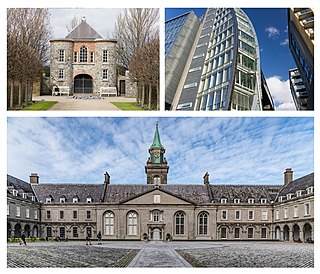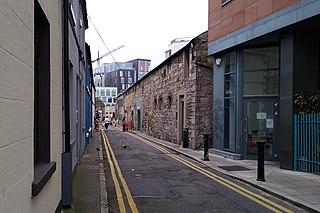Related Research Articles

Waterford is a city in County Waterford in the south-east of Ireland. It is located within the province of Munster. The city is situated at the head of Waterford Harbour. It is the oldest and the fifth most populous city in the Republic of Ireland. It is the ninth most populous settlement on the island of Ireland. According to the 2022 census, 60,079 people live in the city, with a wider metropolitan population of 82,963.

The City Hall, Dublin, originally the Royal Exchange, is a civic building in Dublin, Ireland. It was built between 1769 and 1779, to the designs of architect Thomas Cooley, and is a notable example of 18th-century architecture in the city. Originally used by the merchants of the city, it is today the formal seat of Dublin City Council.

Kilmainham is a south inner suburb of Dublin, Ireland, south of the River Liffey and west of the city centre. It is in the city's Dublin 8 postal district.

The Liberties is an area in central Dublin, Ireland, located in the southwest of the inner city. Formed from various areas of special manorial jurisdiction, separate from the main city government, it is one of Dublin's most historic working class neighbourhoods. The area was traditionally associated with the River Poddle, market traders and local family-owned businesses, as well as the Guinness brewery, whiskey distilling, and, historically, the textiles industry and tenement housing.

Douglas is a suburb, with a village core, in Cork city, Ireland. Douglas is also the name of the townland, Roman Catholic parish, Church of Ireland parish and civil parish in which it is contained.

The River Poddle is a river in Dublin, Ireland, a pool of which gave the city its English language name. Boosted by a channel made by the Abbey of St. Thomas à Becket, taking water from the far larger River Dodder, the Poddle was the main source of drinking water for the city for more than 500 years, from the 1240s. The Poddle, which flows wholly within the traditional County Dublin, is one of around a hundred members of the River Liffey system, and one of over 135 watercourses in the county; it has just one significant natural tributary, the Commons Water from Crumlin.
"The Rare Ould Times" is a song composed by Pete St. John in the 1970s for the Dublin City Ramblers. It is sometimes called "Dublin in the Rare Ould Times", "The Rare Old Times", or "The Rare Auld Times".

Marrowbone Lane is a street off Cork Street on the south side of Dublin, Ireland.

Dame Street is a large thoroughfare in Dublin, Ireland.
The Manor of St. Sepulchre was one of several manors, or liberties, that existed in Dublin, Ireland since the arrival of the Anglo-Normans in the 12th century. They were townlands united to the city, but still preserving their own jurisdiction. St. Sepulchre's was under the jurisdiction of the Archbishop of Dublin, although from time to time the Dublin city government claimed ownership of it.

The Liberty of Thomas Court and Donore was one of several manors, or liberties, that existed in County Dublin, Ireland since the arrival of the Anglo-Normans in the 12th century. They were adjacent to Dublin city, and later entirely surrounded by it, but still preserving their own separate jurisdiction.

St. Luke's Church is a former Church of Ireland parish church in Dublin, Ireland. It is located on The Coombe, not far from St. Patrick's Cathedral.

The Coombe is a historic street in the south inner city of Dublin, Ireland. It was originally a hollow or valley where a tributary of the River Poddle, the Coombe Stream or Commons Water, ran. The name is sometimes used for the broader area around, in which the Poddle and its related watercourses featured strongly.

Fumbally Lane is a narrow and historic street in Dublin, Ireland, south of the city centre in The Liberties, 'In name and character perhaps the most evocative of all the Liberties' streets.' It connects Blackpitts to New Street and is close to St Patrick's Cathedral.

Newtown Pery is an area of central Limerick, Ireland, and forms the main city centre of the city. The district is known for its Georgian architectural heritage and is the core area of Limerick's Georgian Quarter. It is one of the three towns that make up modern-day Limerick City Centre, the other two being the older Englishtown and Irishtown, which date from the medieval period. Newtown Pery houses the largest collection of Georgian townhouses in Ireland outside of Dublin. In 1837, Samuel Lewis in his Topographical Dictionary of Ireland described Newtown Pery as "one of the handsomest towns in Ireland".

Weavers' Hall was a guildhall at 14 The Coombe, Dublin, Ireland, which housed the Guild of Weavers, one of the 25 Guilds of the City of Dublin. The building was constructed in 1745 to a design by architect Joseph Jarratt to replace an earlier nearby weavers' guildhall in the Lower Coombe which was built in 1681–2 and was located in what was originally the Earl of Meath's Liberty. The building was demolished in 1965, with elements including furniture, fireplaces, door surrounds and stone floors sold off as scrap.

Cuffe Street is a street in Dublin, Ireland which runs from St Stephen's Green at the eastern end to Kevin Street Lower at the western end.

Ship Street Little is a street on the south side of Dublin, Ireland which stretches from Werburgh Street and Bride Street in the west to the corner with Ship Street Great and Cole Alley and is bookended by the Ship Street Gate of Dublin Castle in the east.
References
- ↑ Johnston, Máirín (1985). Around the Banks of Pimlico. Attic Press. ISBN 9780946211166.
- ↑ "Dublin's lost buildings: The Dutch Billy | Irish Archaeology". irisharchaeology.ie. 10 March 2012. Retrieved 22 January 2024.
- ↑ Coates, Richard (1 September 1995). "The First American Placename in England: Pimlico". Names. pp. 213–227. doi:10.1179/nam.1995.43.3.213 . Retrieved 22 January 2024.
- ↑ "Tripoli - Dublin Street Directory 1862". www.libraryireland.com. Retrieved 22 January 2024.
- ↑ "Newmarket and Weavers' Square" (PDF). www.dublincity.ie/. Retrieved 22 January 2024.
- ↑ Gillespie, Elgy (1977). The Liberties of Dublin. p. 110. ISBN 9780905140247.
"The Banks of Pimlico" became popular as a music hall song [..] in the 19th century
- ↑ Curtis, Maurice (2013). The Liberties: A History. The History Press. ISBN 9780752490328.
The song refers to Pimlico and the 'rebel Liberties'. He [St John] composed it originally for the Dublin City Ramblers
53°20′28″N6°16′54.4″W / 53.34111°N 6.281778°W